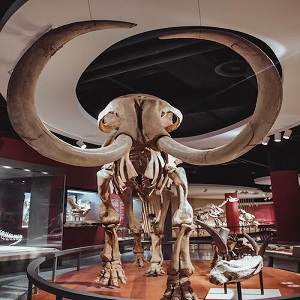Introduction to Mammoths:
Mammoths, the colossal relatives of modern elephants, occupy a fascinating place in the annals of Earth’s history. These magnificent creatures belong to the family Elephantiac and are often envisioned as emblematic of the Ice Age. They emerged around 5 million years ago, evolving from smaller, more primitive ancestors. Their remarkable adaptations enabled them to thrive in various environments, from the frozen tundra’s of the northern latitudes to grassy savannas.
Characterized by their massive size, shaggy coats, and distinctive curved tusks, mammoths captivate both scientists and the general public. The woolly mammoth, specifically adapted to colder climates, is one of the most iconic species. These ancient beasts interacted with early human populations, influencing Paleolithic cultures and appearing in ancient art and legends.
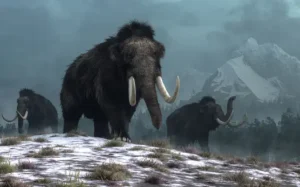
Tragically, they faced extinction around 10,000 years ago, marking the close of the Pleistocene epoch. The reasons behind their decline continue to spark debate, encompassing factors such as climate change, habitat alteration, and human predation. However, recent scientific breakthroughs have even raised the possibility of their de-extinction through advanced genetic techniques.
In this exploration, we will journey into the realms of mammoth evolution, their physical attributes, historical significance, and the complex web of factors that led to their eventual disappearance. Delving into the world of mammoths offers not only a glimpse into prehistoric landscapes but also a greater understanding of the delicate interplay between species and the environment.
Evolution and Classification:
They are a group of extinct, large mammals belonging to the family Elephantiac. They are closely related to modern elephants and are often referred to as their distant cousins. The evolutionary history of their spans millions of years and is intricately linked to changes in Earth’s climate and landscapes.
They are classified within the subfamily Elephantine, which also includes modern elephants. The genus Mammoths encompasses various species of mammoths that evolved and adapted to different environments over time. Some of the most well-known species include the woolly mammoth and the Columbian mammoth.
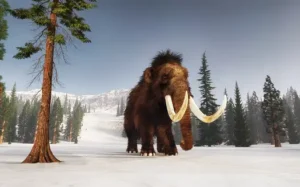
The ancestors of mammoths can be traced back to early elephant-like mammals that lived during the Miocene epoch. Over time, these ancestral forms gradually evolved larger body sizes, longer tusks, and adaptations suited to cold environments. During the Pleistocene epoch, they diversified into various species, each adapted to specific habitats ranging from grasslands to tundra regions.
The classification of mammoths is based on fossil evidence, including skeletal remains, teeth, and genetic studies. Advances in DNA analysis have provided insights into their relationships with modern elephants and the interconnections among different mammoth species.
Understanding the evolution and classification of mammoths not only sheds light on their own history but also contributes to our broader understanding of evolutionary processes, ecological interactions, and the effects of changing environments on species adaptation and extinction.
Physical Characteristics:
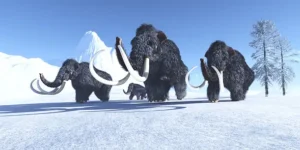
They members of the Elephantid family, were remarkable creatures that roamed the Earth during the Pleistocene epoch. One of the most striking aspects of their physical characteristics was their immense size. Standing tall with an average shoulder height of around 10 to 12 feet (3 to 3.7 meters) and weighing between 5 to 8 tons, mammoths were well adapted to cold climates. Their massive bodies were covered in a thick layer of fur, which helped them withstand the harsh conditions of the Ice Age.
Perhaps the most iconic feature of mammoths was their long, curved tusks. These tusks, which could reach lengths of up to 16 feet (4.9 meters) in some species, served various purposes. They were used for digging through snow to access vegetation, foraging for food, and even in interactions with other mammoths or predators. The tusks also played a role in regulating body temperature; by exposing them to the cold air, mammoths could dissipate excess heat and prevent overheating.
They had a hump of fat on their backs, similar to modern-day camels, which likely helped them store energy and regulate their metabolism in environments where food could be scarce. Their large, flat feet were well-suited for traversing different terrains, distributing their immense weight and preventing them from sinking into softer surfaces like snow or mud.
The fur of mammoths varied among different species and adapted to the climates they inhabited. In colder regions, mammoths had a dense undercoat beneath their longer outer fur, providing them with insulation against the cold. As the climate changed over time, mammoths in different areas developed specific adaptations to survive in their particular environments.
Overall, the physical characteristics of them were marvels of adaptation to the challenges of the Ice Age world. Their size, tusks, fur, and other unique features enabled them to thrive in diverse environments, making them an iconic and fascinating species in the Earth’s history.
Aldabra Giant Tortoise: 15 Most Useful Points
Habitat and Distribution:
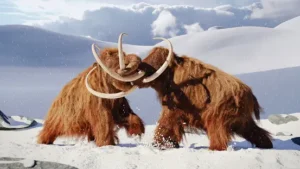
They are large and iconic creatures closely related to modern-day elephants, once inhabited a diverse range of habitats across the globe. These prehistoric giants were adapted to various environments, displaying an impressive ability to thrive in diverse conditions during the Pleistocene epoch, which spanned from about 2.6 million to 11,700 years ago.
The habitat and distribution of mammoths were strongly influenced by the changing climate patterns of the Pleistocene. During this era, the Earth experienced several glacial and interglacial periods, leading to fluctuations in temperature and sea levels that greatly impacted ecosystems. As a result, mammoths could be found in a wide array of landscapes, including grasslands, tundra, shrublands, and even semi-desert regions.
One of the most well-known species, the Woolly Mammoth (They prim genius), was superbly adapted to cold environments. These mammoths roamed the vast tundra of northern Eurasia and North America, areas that were rich in grasses, sedges, and other cold-resistant vegetation. Their distinctive long, curved tusks, shaggy coats of fur, and humped shoulders were evolved features that helped them survive the harsh winters of the Pleistocene ice ages.
In addition to the Woolly Mammoth, other species such as the Columbian Mammoth occupied different niches. The Columbian Mammoth, characterized by its larger size and relatively shorter hair, inhabited more temperate environments like grasslands and savannahs across North and Central America.
The range of their species extended far and wide. They could be found as far east as Siberia, as far west as North America, and as far south as parts of Mexico and Central America. The Bering land bridge, which periodically connected Siberia and Alaska due to lower sea levels during glacial periods, facilitated the movement of them between Eurasia and North America.
Sadly, the end of the Pleistocene epoch brought about the extinction of most mammoth species. The causes of this extinction are still debated, with a combination of factors such as climate change, habitat loss, and human hunting likely contributing. The disappearance of their marked the end of an era and a significant shift in ecosystems that had been shaped by these magnificent creatures for millions of years.
Paleolithic Interactions:
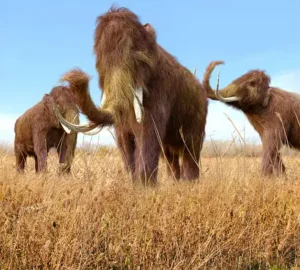
During the Paleolithic era, early humans had intriguing interactions with mammoths that left significant marks on both human history and the natural world. These interactions were shaped by the presence of these massive creatures in the same ecosystems that early humans inhabited.
One of the most prominent aspects of these interactions was the role they played as a valuable resource for early human populations. They meat provided a substantial source of food, while their hides were used for clothing and shelter. The tusks, made of ivory, were fashioned into tools, ornaments, and art objects. This dependence on mammoths as a critical resource shaped the strategies and behaviors of early human societies, leading to organized hunting efforts and communal living to manage and exploit these resources effectively.
Artistic depictions of mammoths found in cave paintings and sculptures further illustrate their significance in the lives of early humans. These intricate artworks suggest a cultural and perhaps even spiritual connection between humans and them. These depictions serve as a window into the worldview of our ancient ancestors, showcasing their reverence for these awe-inspiring creatures and possibly their attempts to communicate stories, rituals, or beliefs related to them.
The presence of their also influenced the broader ecosystems of the time. As large herbivores, they played a pivotal role in shaping landscapes through their grazing habits. Their feeding behaviors contributed to maintaining grasslands and preventing the encroachment of forests in certain regions. The alteration of landscapes by them, in turn, impacted the availability of resources for other species, influencing the distribution and abundance of various plant and animal populations.
In conclusion, the interactions between early humans and mammoths during the Paleolithic era were multifaceted. They were not just a source of sustenance but also a source of inspiration for art and culture, and their ecological impact resonated throughout their ecosystems. Understanding these interactions offers us a glimpse into the complex relationship between humans and the natural world, shedding light on how our ancestors navigated their environment and utilized its resources.
Extinction Theories:
The extinction of mammoths, iconic creatures of the Ice Age, is a subject that has intrigued scientists for decades. Multiple theories attempt to explain their disappearance around 10,000 years ago, but none provide a definitive answer. These extinction theories can be broadly categorized into two main groups: climatic factors and human impact.
Climatic factors propose that they fell victim to the changing environmental conditions of the late Pleistocene epoch. The most prominent theory in this category is the Pleistocene Overkill Hypothesis, suggesting that the combination of climatic changes, such as the warming at the end of the last Ice Age, and natural habitat shifts caused a decline in their populations. This made them more vulnerable to predation and scarcity of resources, eventually leading to their extinction. Another climatic theory is the Younger Dryas Impact Hypothesis, which proposes that an asteroid impact triggered a sudden and severe cooling event that disrupted ecosystems and severely impacted their populations.
Human impact theories emphasize the role of early humans in the extinction of them. Overhunting is a widely debated theory, suggesting that human populations, armed with advanced hunting tools, played a significant role in decimating mammoth populations. Archaeological evidence of their bones with human-made tools and butchering marks supports this argument. Additionally, habitat destruction caused by human activities, such as the widespread use of fire to modify landscapes, could have contributed to the decline of mammoth habitats.
While these theories hold merit individually, many scientists believe that a combination of factors likely led to the extinction of them. Climate change, human predation, and habitat alteration likely interacted in complex ways, creating a cascade of effects that ultimately pushed mammoths to the brink. The exact sequence of events remains a subject of ongoing research and debate. Understanding the extinction of their not only sheds light on the past but also carries lessons for modern conservation efforts, emphasizing the delicate balance between environmental change and the impact of human activities on fragile ecosystems.
Mammoth Discoveries:
They are the colossal relatives of modern-day elephants, have left an indelible mark on the annals of paleontology through a series of remarkable discoveries. These findings have provided invaluable insights into the lives of these ancient creatures and the ecosystems they once inhabited.
One of the most iconic mammoth discoveries occurred in the frozen tundra’s of Siberia. The preserved remains of woolly mammoths, with their intricate details intact, have been unearthed from the permafrost. These frozen carcasses have provided scientists with an unparalleled opportunity to study the physical attributes, dietary habits, and even the potential causes of their demise. They well-preserved hair, skin, and soft tissues have given researchers an astonishing window into their appearance and adaptations to the Ice Age environment.
Moreover, archaeological sites have revealed evidence of early human interactions with them. Cave paintings, carvings, and sculptures depicting these majestic creatures offer glimpses into the cultural significance and coexistence of mammoths with prehistoric societies. These discoveries not only shed light on the artistic capabilities of our ancestors but also provide clues about the ways in which they were perceived and utilized.
In recent years, advances in technology have propelled mammoth discoveries into the realm of genetic research. Extracting DNA from ancient mammoth bones and analyzing it has opened up possibilities for understanding their genetic makeup, evolutionary history, and potential relationships with modern elephants. This genetic information has also sparked discussions about the feasibility of mammoth de-extinction through genetic engineering.
As technology continues to advance, new tools such as high-resolution imaging and 3D scanning have enabled scientists to study mammoth remains in unprecedented detail. These techniques have allowed researchers to reconstruct digital models of their skeletons and gain insights into their locomotion, anatomy, and growth patterns.
In conclusion, their discoveries have captivated the world with their remarkable preservation and the stories they unveil about Earth’s past. From frozen remains to ancient art, these findings provide a multifaceted perspective on mammoths and their interactions with both their environment and early human civilizations. As scientific methods evolve, these discoveries are likely to keep unraveling new layers of information, enhancing our understanding of these magnificent creatures that once roamed the Earth.
Horned Lizard: 20 Most Important things For Pets Lover
Cloning and De-extinction:
Cloning and de-extinction have emerged as captivating topics in the realm of science and biology, promising the resurrection of long-extinct species like them. The concept of bringing back mammoths from the past has captured the imagination of both researchers and the public alike, although it raises a multitude of ethical, scientific, and ecological questions.
Cloning them involves retrieving intact DNA from well-preserved specimens found in frozen environments like Siberian permafrost. This DNA can be used as a template to reconstruct the complete genetic code of the mammoth. However, the challenges are substantial. The DNA extracted is often fragmented and degraded due to the passage of time. Scientists need to find suitable surrogate mothers from related species, such as modern elephants, to carry cloned mammoth embryos to term.
The ethical considerations surrounding their de-extinction are complex. Critics argue that the resources and efforts devoted to reviving extinct species could be better employed for the conservation of endangered species and the preservation of existing ecosystems. There are concerns about whether these “resurrected” mammoths would truly be the same as their ancient counterparts, given that their environments have changed significantly since their extinction.
From an ecological perspective, reintroducing mammoths to their former habitats could potentially have positive impacts. They were ecosystem engineers, shaping landscapes through their feeding habits and contributing to the distribution of plant seeds. Their presence could influence vegetation patterns and potentially mitigate the effects of climate change.
While cloning and de-extinction technologies are advancing, they are far from perfect. Technical challenges, ethical dilemmas, and uncertainties about ecological consequences make the process a subject of ongoing debate. Ultimately, the pursuit of their de-extinction raises profound questions about the boundaries of science, our role in shaping the natural world, and the potential consequences of manipulating ecosystems for our own desires.
In conclusion, cloning and de-extinction efforts aimed at resurrecting mammoths are fascinating scientific endeavors with the potential to reshape our understanding of extinction, genetics, and ecology. However, they also provoke contentious discussions about the balance between scientific progress, ethical considerations, and the long-term impact on ecosystems. The saga of their de-extinction underscores the intricate interplay between science, ethics, and the natural world.
Mammoth’s Role in Ecosystems:
They are an iconic Ice Age megafauna, played a crucial and multifaceted role in the ecosystems it inhabited. As large herbivores, they significantly shaped their environments through their feeding behaviors, movement patterns, and interactions with other species.
They primarily inhabited open grasslands and tundra regions, where their grazing activities had a profound impact on vegetation dynamics. Their constant grazing helped maintain grasslands by preventing the encroachment of woody plants and maintaining a diverse range of plant species. This, in turn, supported a variety of other herbivores and had a cascading effect on the entire ecosystem.
Furthermore, mammoths were known to disturb the ground while foraging, creating small depressions or disturbances that collected rainwater. These areas would often become mini wetlands, attracting a diverse array of plant and animal species that were essential for the overall biodiversity of the region. These depressions also aided in nutrient cycling by facilitating water retention and soil enrichment.
The ecological influence of mammoths extended beyond plant communities. Their tusks and bones provided resources for scavengers and carnivores. Additionally, their trampling activities influenced soil compaction and nutrient distribution, affecting soil health and plant growth patterns. This interaction between mammoths and their environment demonstrates the intricate ways in which large herbivores can shape the landscapes they inhabit.
The eventual extinction of mammoths had far-reaching consequences for the ecosystems they once inhabited. The loss of their grazing and disturbance behaviors might have contributed to changes in vegetation composition, altered nutrient cycling, and impacted the populations of species that relied on mammoths in some way.
Today, there is ongoing debate about the potential benefits of reintroducing mammoth-like species (through genetic engineering or selective breeding) to help manage modern ecosystems, particularly those affected by overgrown vegetation and disrupted nutrient cycling due to the absence of large herbivores.
In conclusion, the mammoth’s role in ecosystems was not merely that of a large herbivore; it was a transformative force that influenced vegetation, water distribution, soil health, and biodiversity. Understanding the ecological impacts of mammoths provides valuable insights into the intricate relationships between species and their environments and offers potential lessons for modern conservation and ecosystem management efforts.
Cultural Significance:
Mammoths, with their colossal size and prehistoric aura, hold a deep and enduring cultural significance across various civilizations and periods of history. They have left an indelible mark on human imagination, art, and scientific inquiry.
In many ancient cultures, mammoth remains were often unearthed, sparking wonder and curiosity. Early humans encountered mammoth fossils, leading to myths and legends about giants from a bygone era. These encounters likely fueled the creation of folklore and tales of mythical creatures, shaping the narratives of ancient societies.
Art has also been a vessel through which mammoths have captured human fascination. From Paleolithic cave paintings to intricate sculptures, mammoths have been a subject of artistic expression for millennia. These depictions not only showcase the artistic talents of their creators but also serve as a connection to our ancient ancestors’ experiences and perceptions of the natural world.
The symbolic importance of mammoths extends beyond their physical representation. They have been used as icons of strength, resilience, and survival. Mammoth imagery has been incorporated into coats of arms, emblems, and totems of various cultures, embodying characteristics that societies have aspired to possess.
In modern times, mammoths continue to inspire scientists, writers, and filmmakers. The pursuit of understanding mammoths’ biology and behaviors has driven paleontological research, uncovering insights into Earth’s history and evolutionary processes. Moreover, the concept of de-extinction, while ethically complex, has sparked discussions about our responsibility towards the preservation of species and ecosystems.
Mammoths have also become emblematic of environmental concerns. As ancient grassland grazers, they hold relevance in contemporary discussions about landscape management and biodiversity restoration. The potential reintroduction of mammoths to habitats where they once roamed raises questions about the role of humans in ecological restoration and the potential positive impacts on ecosystems.
In conclusion, the cultural significance of mammoths is woven deeply into the fabric of human history and creativity. They bridge the gap between our distant past and our aspirations for the future, connecting us to the natural world and our own evolving relationship with it.
FAQ’s:
What is a mammoth?
A mammoth is a large, extinct species of elephant that lived during the Ice Age. They were characterized by their long, curved tusks, shaggy hair, and adaptations for cold climates.
When did mammoths exist?
Mammoths existed during the Pleistocene epoch, which lasted from about 2.6 million years ago to around 11,700 years ago.
Were mammoths similar to modern-day elephants?
Yes, mammoths were closely related to modern elephants. They shared many physical and behavioral traits, but mammoths were adapted to cold environments and had certain features like a hump of fat and a woolly coat to withstand the cold.
How did mammoths go extinct?
The exact cause of mammoth extinction is debated, but a combination of factors likely contributed, including climate change, habitat loss, and human hunting. The warming climate at the end of the Ice Age and human activities likely played significant roles.
Is it possible to bring back mammoths using cloning?
There has been ongoing research into using cloning and genetic engineering to potentially bring back mammoths, a process known as de-extinction. While some progress has been made, there are ethical and technical challenges to overcome, and the concept remains controversial.
